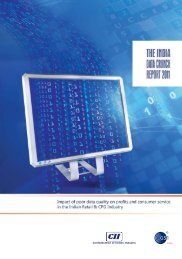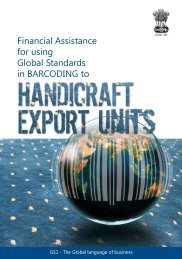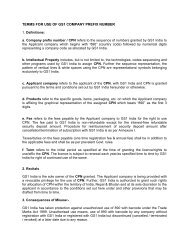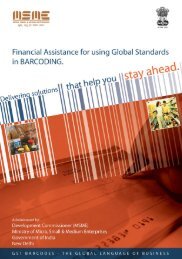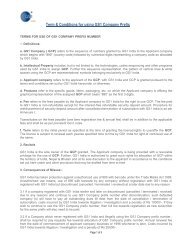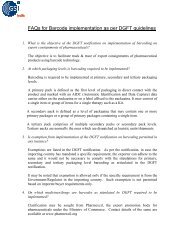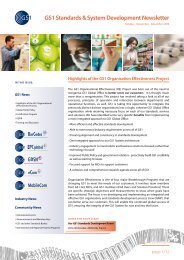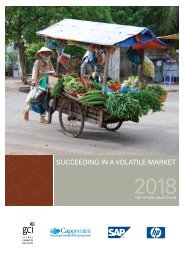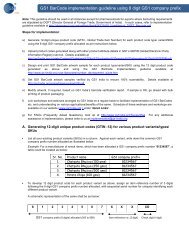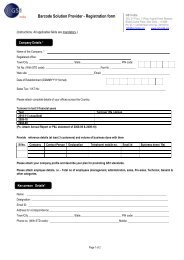Case study: GS1 DataBar applications from around the world
Case study: GS1 DataBar applications from around the world
Case study: GS1 DataBar applications from around the world
Create successful ePaper yourself
Turn your PDF publications into a flip-book with our unique Google optimized e-Paper software.
<strong>Case</strong> Study<br />
<strong>GS1</strong> <strong>DataBar</strong> <strong>applications</strong> <strong>from</strong> <strong>around</strong> <strong>the</strong> <strong>world</strong><br />
<strong>GS1</strong> <strong>DataBar</strong> is a new bar code that can deliver enhanced product identification at retail point-of-sale (POS).<br />
It has unique features that open up new opportunities for retailers and manufacturers today:<br />
<br />
OR<br />
<br />
It is smaller – up to half <strong>the</strong> size of <strong>the</strong> existing standard <strong>GS1</strong> bar codes used at POS in <strong>the</strong> retail sector<br />
globally. Many smaller consumer products which previously could not be bar coded, such as fresh<br />
produce, cosmetics and pharmaceuticals, can now enjoy <strong>the</strong> same benefits <strong>from</strong> bar coding as <strong>the</strong><br />
majority of products do today. It also allows more space on packaging for branding and regulatory<br />
requirements.<br />
It is able to encode additional product information such as weights, expiry dates and prices. Currently,<br />
only basic product identification can be encoded in a bar code scanned at retail POS.<br />
It is currently being trialled and implemented by retailers and manufacturers throughout <strong>the</strong> <strong>world</strong> as<br />
demonstrated in <strong>the</strong> following case studies.<br />
1. Implementing <strong>GS1</strong> <strong>DataBar</strong> with fresh produce in Canada<br />
Introduction<br />
Loblaw Companies Limited is Canada’s largest retailer with more than 1,000 corporate and franchised<br />
stores. The company ships on average 26,662,929 kg (1,900 truck loads) of fresh produce per week.<br />
In 2007, Loblaw engaged in a limited implementation of <strong>GS1</strong> <strong>DataBar</strong> with specific suppliers of apples and<br />
bananas. Following <strong>the</strong> success of its initial implementation, <strong>the</strong> company decided to expand <strong>the</strong> use of <strong>GS1</strong><br />
<strong>DataBar</strong> to all of its fresh produce.<br />
Significant benefits<br />
The company has recognised <strong>the</strong> following benefits <strong>from</strong> using <strong>GS1</strong><br />
<strong>DataBar</strong> on fresh produce:<br />
• Improved accuracy and speed at <strong>the</strong> retail POS for fresh<br />
produce by eliminating Price Look-Up (PLU) number entry<br />
errors by cashiers<br />
• Improved accuracy and speed at self-checkout<br />
• Reduced shrinkage<br />
• Improved stock control by better differentiation of organic and<br />
conventional produce<br />
• More accurate product replenishment<br />
• Improved supplier identification.<br />
During <strong>the</strong> implementation, Loblaw found that <strong>the</strong> scanning of <strong>GS1</strong><br />
<strong>DataBar</strong> had not been an issue for its cashiers provided <strong>the</strong> codes were printed within specification and <strong>the</strong><br />
produce bags that were used did not impair <strong>the</strong> ability to read <strong>the</strong> new bar code. Self check-out customers<br />
also preferred <strong>the</strong> process of scanning fruit and vegetables using <strong>GS1</strong> <strong>DataBar</strong> labels.<br />
Traceability of fresh produce within <strong>the</strong> company has also been enhanced following <strong>the</strong> implementation. The<br />
company achieved improved supply chain efficiency through <strong>the</strong> use of <strong>GS1</strong> <strong>DataBar</strong> labels on its fresh<br />
produce.<br />
Conclusion<br />
“The benefits of implementing <strong>GS1</strong> <strong>DataBar</strong> will truly be achieved when all trading partners are<br />
aligned to a single solution for fresh produce. This is why it’s so important that all retailers engage in<br />
a <strong>GS1</strong> <strong>DataBar</strong> implementation program,” says Eric Biddiscombe, Senior Director Planning, Produce<br />
Business Unit, Loblaw Companies Ltd.<br />
-1-
<strong>Case</strong> <strong>study</strong>: <strong>GS1</strong> <strong>DataBar</strong> <strong>applications</strong> <strong>from</strong> <strong>around</strong> <strong>the</strong> <strong>world</strong><br />
2. Keeping sushi fresh by <strong>the</strong> hour in Japan with <strong>GS1</strong> <strong>DataBar</strong><br />
Introduction<br />
In Japan consumers are generally frequent food shoppers and<br />
are <strong>the</strong>refore very particular about freshness and quality of fresh<br />
produce. As a result, retailers have been encoding additional<br />
data, such as expiry dates, in bar codes for some years, often<br />
using different carriers such as <strong>GS1</strong>-128 or additional EAN-13<br />
symbols.<br />
In 2008, two leading Japanese retailers, Bunkado and Beisia,<br />
conducted <strong>GS1</strong> <strong>DataBar</strong> pilots to take advantage of its ability to<br />
encode additional data such as expiry dates and hours in a<br />
single bar code symbol using <strong>the</strong> existing <strong>GS1</strong> Application<br />
Identifier (AI) standard. Both retailers used similar data in <strong>the</strong><br />
pilot: <strong>the</strong> GTIN (Global Trade Item Number) or internal product<br />
identification numbers, mark down pricing information and <strong>the</strong><br />
expiry date and time AI.<br />
Significant benefits<br />
During <strong>the</strong> pilot, staff prepared take-away meals in-store with<br />
lunch boxes and side dishes such as sushi and sashimi prepared<br />
two or three times a day. Many of <strong>the</strong> items had a short shelf life<br />
with some kept for less than 24 hours. The freshness of <strong>the</strong><br />
products were checked regularly so that discounts could be<br />
given to products that were approaching <strong>the</strong> end of <strong>the</strong>ir shelf life<br />
in order to promote sales. This discounts were done by printing<br />
and applying a new <strong>GS1</strong> <strong>DataBar</strong> Expanded label to <strong>the</strong> product.<br />
The discount information, ei<strong>the</strong>r as a percentage or fixed<br />
amount, was encoded into <strong>the</strong> symbol. Cashiers were <strong>the</strong>n able<br />
to scan <strong>the</strong> discounted product quickly and accurately at POS<br />
instead of manually keying in <strong>the</strong> information.<br />
Freshness check at <strong>the</strong> shelf<br />
Sushi carrying sell-by hour<br />
Staff were also able to easily remove any products that had<br />
passed <strong>the</strong> expiry hour or date whilst <strong>the</strong>y were checking <strong>the</strong><br />
product freshness. The retailers also configured <strong>the</strong>ir POS<br />
systems so that any products which were scanned after <strong>the</strong>ir<br />
expiry hour or date were rejected. The checkout staff would <strong>the</strong>n<br />
be alerted to sell a fresh replacement product instead.<br />
Conclusion<br />
Following <strong>the</strong> success of <strong>the</strong> trial, Bunkado and Beisia have<br />
started implementing a similar mark-down process using <strong>GS1</strong><br />
<strong>DataBar</strong> on o<strong>the</strong>r products, such as milk, yogurt and tofu<br />
(products with relatively short-shelf lives).<br />
Yogurt with GTIN and markdown<br />
-2-<br />
25/09/2009
<strong>Case</strong> <strong>study</strong>: <strong>GS1</strong> <strong>DataBar</strong> <strong>applications</strong> <strong>from</strong> <strong>around</strong> <strong>the</strong> <strong>world</strong><br />
3. The Dutch DIY and gardening sector find potential benefits in <strong>GS1</strong> <strong>DataBar</strong><br />
The Do-It-Yourself (DIY) and gardening retail sectors in The Ne<strong>the</strong>rlands have been quick to see <strong>the</strong><br />
potential of <strong>GS1</strong> <strong>DataBar</strong>. Following <strong>the</strong> initial focus on getting ready to scan <strong>GS1</strong> <strong>DataBar</strong> across <strong>the</strong><br />
supply chain, strong interest has been shown in specific <strong>applications</strong> areas where significant benefits could<br />
be achieved.<br />
The two largest DIY retailers in <strong>the</strong> Ne<strong>the</strong>rlands (and Belgium where <strong>the</strong>y also operate) have been<br />
researching <strong>the</strong> possibility of using <strong>GS1</strong> <strong>DataBar</strong> on loyalty cards.<br />
In addition, gardening retailers and nurseries have been exploring <strong>the</strong> use of<br />
<strong>GS1</strong> <strong>DataBar</strong> to identify flowers and plants and <strong>the</strong>ir cutting or release date<br />
<strong>from</strong> <strong>the</strong> nursery. Plants <strong>from</strong> different dates are usually sold toge<strong>the</strong>r at <strong>the</strong><br />
same price, yet different cutting dates mean <strong>the</strong>y grow and <strong>the</strong>n wi<strong>the</strong>r at<br />
different times. By encoding <strong>the</strong> cutting or release date within <strong>GS1</strong> <strong>DataBar</strong> on<br />
plants using <strong>the</strong> production date AI, retailers will be able to offer discounted<br />
prices on older items. This will ensure improved customer satisfaction and<br />
could encourage <strong>the</strong> sale of older plants.<br />
4. Tracing fresh produce in Chile with <strong>GS1</strong> <strong>DataBar</strong><br />
Introduction<br />
The requirement for product identification and traceability in <strong>the</strong> food industry has become essential,<br />
particularly for a leading exporter such as Chile. Major international buyers of food, especially fruit and<br />
vegetables, are now insisting on <strong>the</strong> use of <strong>GS1</strong> <strong>DataBar</strong> to identify and trace produce throughout <strong>the</strong> global<br />
supply chain. At <strong>the</strong> same time, <strong>the</strong> arrival of new international retailers into Chile has caused <strong>the</strong> domestic<br />
retail industry to become increasingly concerned about international standards, fuelling fur<strong>the</strong>r interest in all<br />
<strong>GS1</strong> standards.<br />
Implementing <strong>GS1</strong> <strong>DataBar</strong> on fresh produce<br />
Many exporting fresh produce companies in Chile including Del Monte, Greenvic,<br />
Tuniche, Geofrut, Magna, Rucaray, San Clemente, Frusan and CyD y Copefrut are<br />
now printing and applying <strong>GS1</strong> <strong>DataBar</strong> labels as part of <strong>the</strong>ir normal production<br />
processes. As with o<strong>the</strong>r fresh produce companies throughout <strong>the</strong> <strong>world</strong>, <strong>the</strong>y are<br />
using <strong>the</strong> <strong>GS1</strong> <strong>DataBar</strong> Stacked Omnidirectional symbols to encode a product’s<br />
GTIN (Global Trade Item Number), toge<strong>the</strong>r with a human readable PLU (Price<br />
Look-Up) number. Many of <strong>the</strong> Chilean exporters have been working with Sinclair<br />
International, one of <strong>the</strong> <strong>world</strong>'s largest suppliers of machinery for labelling fruits.<br />
The two leading grocery retailers in Chile, Cencosud and DyS, are currently<br />
involved in advanced <strong>GS1</strong> <strong>DataBar</strong> trials with <strong>the</strong>ir suppliers and preparing <strong>the</strong>ir<br />
POS scanners to be ready for <strong>GS1</strong> <strong>DataBar</strong>.<br />
Conclusion<br />
The initial interest in <strong>GS1</strong> <strong>DataBar</strong> has been in enhanced identification of fresh produce. However, Chile’s<br />
retailers have also recognised that <strong>GS1</strong> <strong>DataBar</strong> could be used to provide <strong>the</strong> sector with far greater<br />
traceability of all food products. Retailers have also expressed strong interest in <strong>the</strong> identification of variable<br />
measure produce such as meat, chicken and fish.<br />
-3-<br />
25/09/2009
<strong>Case</strong> <strong>study</strong>: <strong>GS1</strong> <strong>DataBar</strong> <strong>applications</strong> <strong>from</strong> <strong>around</strong> <strong>the</strong> <strong>world</strong><br />
5. <strong>GS1</strong> <strong>DataBar</strong> coupons and fresh produce identification lead <strong>the</strong> way in <strong>the</strong> US<br />
The US was an early adopter of <strong>GS1</strong> <strong>DataBar</strong>, with two particular <strong>applications</strong> taking off – coupons and fresh<br />
produce.<br />
Growing uptake of <strong>GS1</strong> <strong>DataBar</strong> coupons<br />
The Joint Industry Coupon Council (JICC) which includes leading<br />
manufacturers, retailers and trade associations continues to support<br />
<strong>the</strong> move to <strong>GS1</strong> <strong>DataBar</strong> and estimates that more than 75% of<br />
manufacturer coupons issued now have both <strong>the</strong> UPC-A and <strong>GS1</strong><br />
<strong>DataBar</strong> symbols.<br />
As different manufacturers determine that enough of <strong>the</strong>ir retailers’<br />
systems are ready to scan <strong>GS1</strong> <strong>DataBar</strong> on coupons, <strong>the</strong><br />
manufacturers will remove <strong>the</strong> UPC-A symbol and rely solely on <strong>the</strong><br />
<strong>GS1</strong> <strong>DataBar</strong> Expanded symbol for POS and clearing house<br />
scanning. The UPC-A bar code is expected to be removed by<br />
January 1, 2011.<br />
Retailers and <strong>the</strong>ir solution providers are currently modifying POS software to process data <strong>from</strong> <strong>GS1</strong><br />
<strong>DataBar</strong> on coupons and will perform extensive testing before deploying <strong>the</strong> software and going live at <strong>the</strong><br />
store level.<br />
Implementing <strong>GS1</strong> <strong>DataBar</strong> on fresh produce<br />
The implementation and use of <strong>GS1</strong> <strong>DataBar</strong> with fresh produce continues to expand in <strong>the</strong> US with leading<br />
supermarkets such as Wal-Mart, Kroger, Winn-Dixie and Publix ei<strong>the</strong>r scanning fresh produce items with<br />
<strong>GS1</strong> <strong>DataBar</strong> or notifying <strong>the</strong>ir suppliers to be ready to provide products with <strong>GS1</strong> <strong>DataBar</strong> soon. According<br />
to Sinclair International, 60% of loose apples and pears and 50% of all loose tomatoes are now bar coded<br />
with <strong>GS1</strong> <strong>DataBar</strong> in North America.<br />
While <strong>the</strong> initial <strong>applications</strong> were with loose produce such as apples, pears, peaches, tomatoes and<br />
nectarines, <strong>the</strong>re has been recent interest <strong>from</strong> grape and cherry suppliers to apply <strong>GS1</strong> <strong>DataBar</strong> symbols<br />
on <strong>the</strong>ir bags to meet retailer requirements.<br />
Conclusion<br />
US retailers that have not implemented <strong>GS1</strong> <strong>DataBar</strong> yet are in <strong>the</strong> process of researching its use on fresh<br />
produce. It is expected that <strong>the</strong>y will begin upgrading <strong>the</strong>ir systems and advising <strong>the</strong>ir suppliers to use <strong>GS1</strong><br />
<strong>DataBar</strong> before it becomes a global, open standard in 2014.<br />
For more information on <strong>GS1</strong> UK log on to<br />
www.gs1uk.org or call <strong>the</strong> <strong>GS1</strong> UK Service Team on Freefone 0808 178 8799<br />
-4-<br />
25/09/2009



